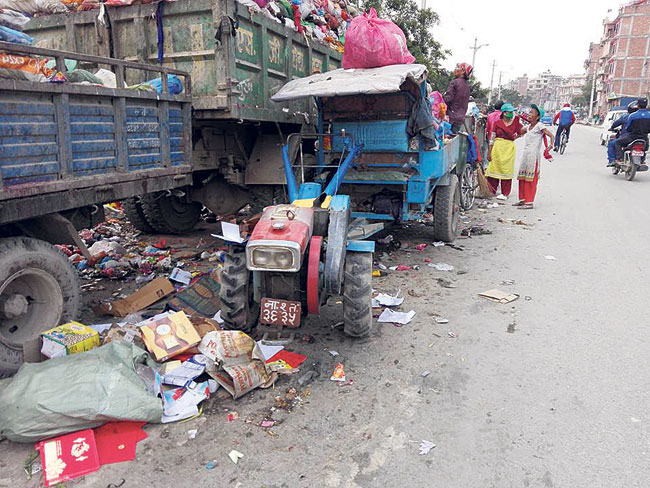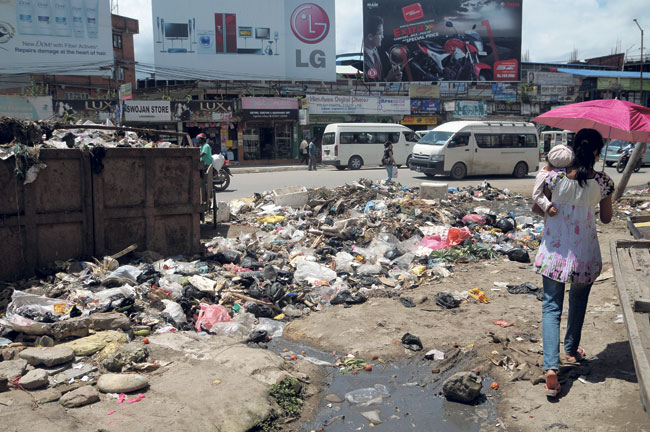Celebrating local craft in Jewelries
6 years ago

6 years ago

6 years ago

6 years ago

6 years ago

6 years ago

KATHMANDU: If you walk along the streets of Kathmandu, you might no longer see the heaps of waste that used to be a common sight a few years back. The credit largely goes to the fact that Kathmandu Metropolitan City (KMC) started penalizing haphazard waste dumpers.
Even with KMC’s efforts, we still have a long way to go in order to have a clean city. Every person generates about 400 gm of waste, including paper, wrappers, tissues, plastic bags and bottles, each day. These waste materials are carelessly thrown out in the streets.
The problem of unmanaged waste is commonly associated with the rise in population. However, according to senior Environmental Engineer Suryaman Shakya, the problem is not only associated with population growth, but also is an indicator of the lack of efforts toward waste management.
KMC Environment Management Department Chief Rabin Man Shrestha said, “It is not that people are unaware about waste management. It is more about people’s attitude toward waste. Most Kathmandu residents are educated enough to know about the importance of waste management. Nobody likes to see their surroundings dirty. But, nobody wants to get their hands dirty either.”

Suryaman added that people were rather busy playing blame game and expecting the government to clean their surroundings. “Valley residents can keep their surroundings clean once they are able to develop the sense of ownership. Putting the responsibility of waste management on government shouldn’t mean extinction of individual efforts.”
Though KMC had installed colorful dustbins for different kinds of waste across the Valley, the office decided to take them down after additional waste started accumulating and management became even more hectic. Even with separate dustbins available, Kathmandu residents were found dumping their organic as well as inorganic waste in a single dustbin. To this, Suryaman added, “Dustbin has never been the solution in Kathmandu.”
“All individuals should be responsible for the waste they generate. The heavy load at dumping sites would decrease if every person understood the ways to segregate their waste,” Aayushi KC of Khaalisisi stated. “It only takes few minutes of your life to know what goes where and what to do with your waste,” said Kushal Harjani, of Doko Recyclers.

Every morning, more than 100 vehicles from KMC make rounds of the Kathmandu Valley and collect a total 1,000 tonnes of waste. As many as 20 garbage trucks then transport the waste to the landfill site in Sisdole, Nuwakot. This way, organic as well as inorganic waste gets dumped in the same landfill, leading to the spread of leachate and possibly contaminating the land as well as water resources nearby.
According to Rabin Man, KMC does not have the infrastructure to segregate the waste once it is collected. He added that the government is doing homework to privatize waste management system and the project is in its last stage.
Though KMC had inaugurated a waste-to-energy plant in June 27, the plant only deals with bio-degradable waste from vegetable markets of the Valley.

One man’s trash is another’s treasure
You should not depend on the government to put your waste in the right place. You can always start by segregating what things you don’t need in your house. “Think before your throw, it’s your social responsibility to manage your waste. If you don’t create problems there won’t be a need for solution,” Dhaasoo’s Nitesh Sharma suggested.
Once you have segregated the waste into dry and wet categories, choose what to do with them. You can make compost out of kitchen waste and for others, you can choose to reuse. Like using old bottles for drinking water, using boxes to store your items or revamp to give them a new look. You can also:

1) Sell/donate
Khaalisisi is an organization that collects the waste from your doorstep at your convenience. You will get a fair price for the waste or you can also chose to donate it. Khaalisisi men on bicycles will collect the waste and dump them at the nearest scrap yard, where many items are recycled.
2) Or Recycle
Doko Recyclers is another organization that has been collecting dry waste from customers. With the help of their own Materials Recovery Facility (MRF), Doko Recyclers package the waste separately and sell them to factories where it is processed for reuse. You can also track where your waste is going.
3) Or Upcycle
If you think any item in your house is too good to be sold or donated, create something new out of it. All you have to do is contact Dhaasoo. Dhaasoo will revamp your old items to give them an aesthetic look and make them reusable. Dhaasoo also accepts e-waste (electronics and gadgets).
Leave A Comment